Strategic Performance Management System Report: Analysis
VerifiedAdded on 2021/06/14
|16
|3656
|48
Report
AI Summary
This report delves into the Strategic Performance Management System (SPMS), focusing on the implementation of the Balanced Scorecard (BSC) within multinational organizations. It explores the BSC's ability to translate strategy into action through strategic alignment and the cause-and-effect relationships within an organization, emphasizing both financial and non-financial perspectives. The report examines the BSC system's four key perspectives: financial, operational, consumer, and people, and how they contribute to organizational objectives. It further analyzes the implementation process, including the top-down and incremental approaches, and the importance of a clear strategic vision. Challenges faced during implementation, such as vague strategies, lack of common vocabulary, and difficulties in initial implementation and cascading to the individual level, are discussed along with corresponding recommendations. The report highlights the significance of financial and non-financial measures, consumer perspectives, internal business processes, and learning and growth perspectives in measuring employee performance. The overall objective is to provide insights into the effective use of SPMS and BSC for enhancing performance management, strategic alignment, and compensation strategies in multinational companies.
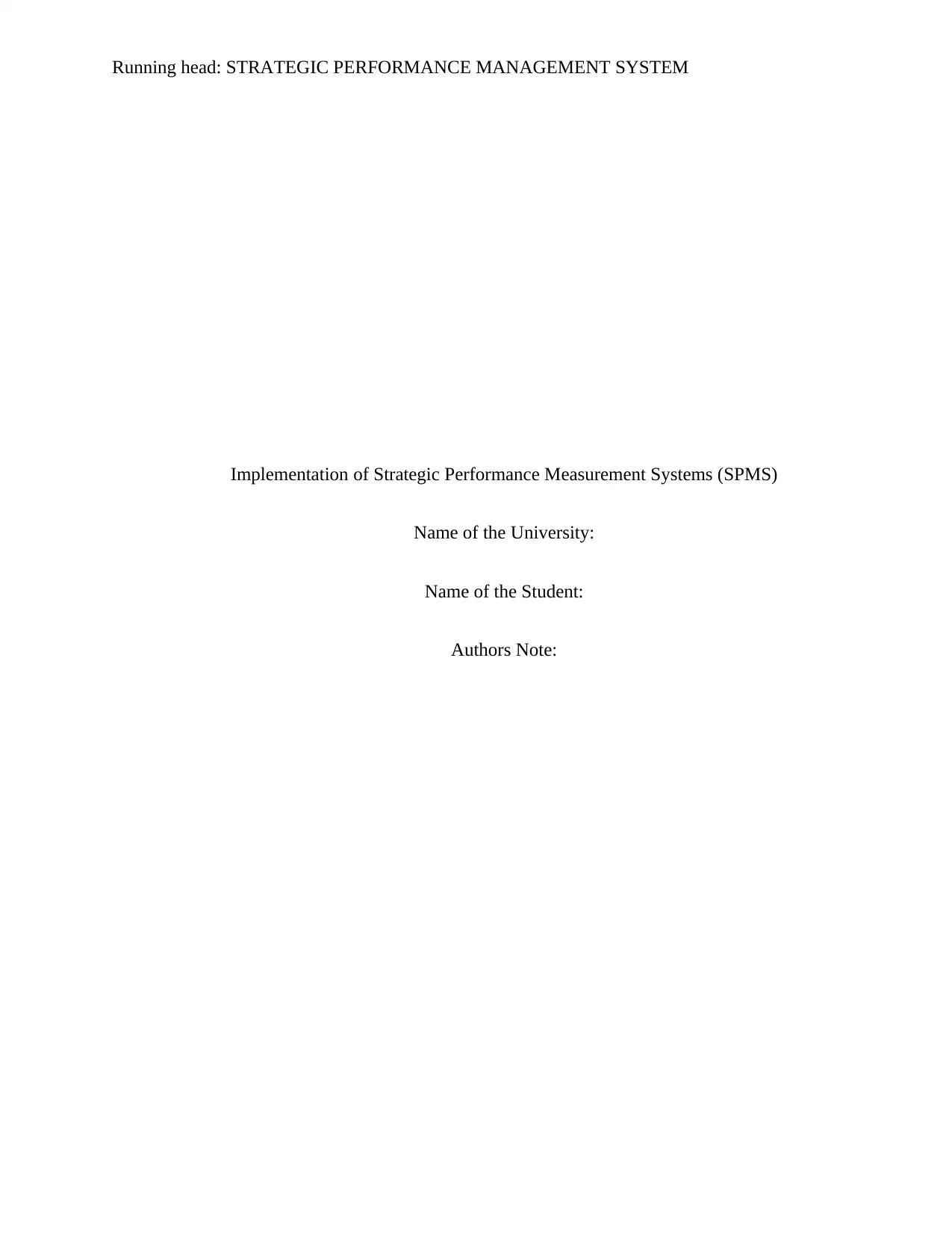
Running head: STRATEGIC PERFORMANCE MANAGEMENT SYSTEM
Implementation of Strategic Performance Measurement Systems (SPMS)
Name of the University:
Name of the Student:
Authors Note:
Implementation of Strategic Performance Measurement Systems (SPMS)
Name of the University:
Name of the Student:
Authors Note:
Paraphrase This Document
Need a fresh take? Get an instant paraphrase of this document with our AI Paraphraser
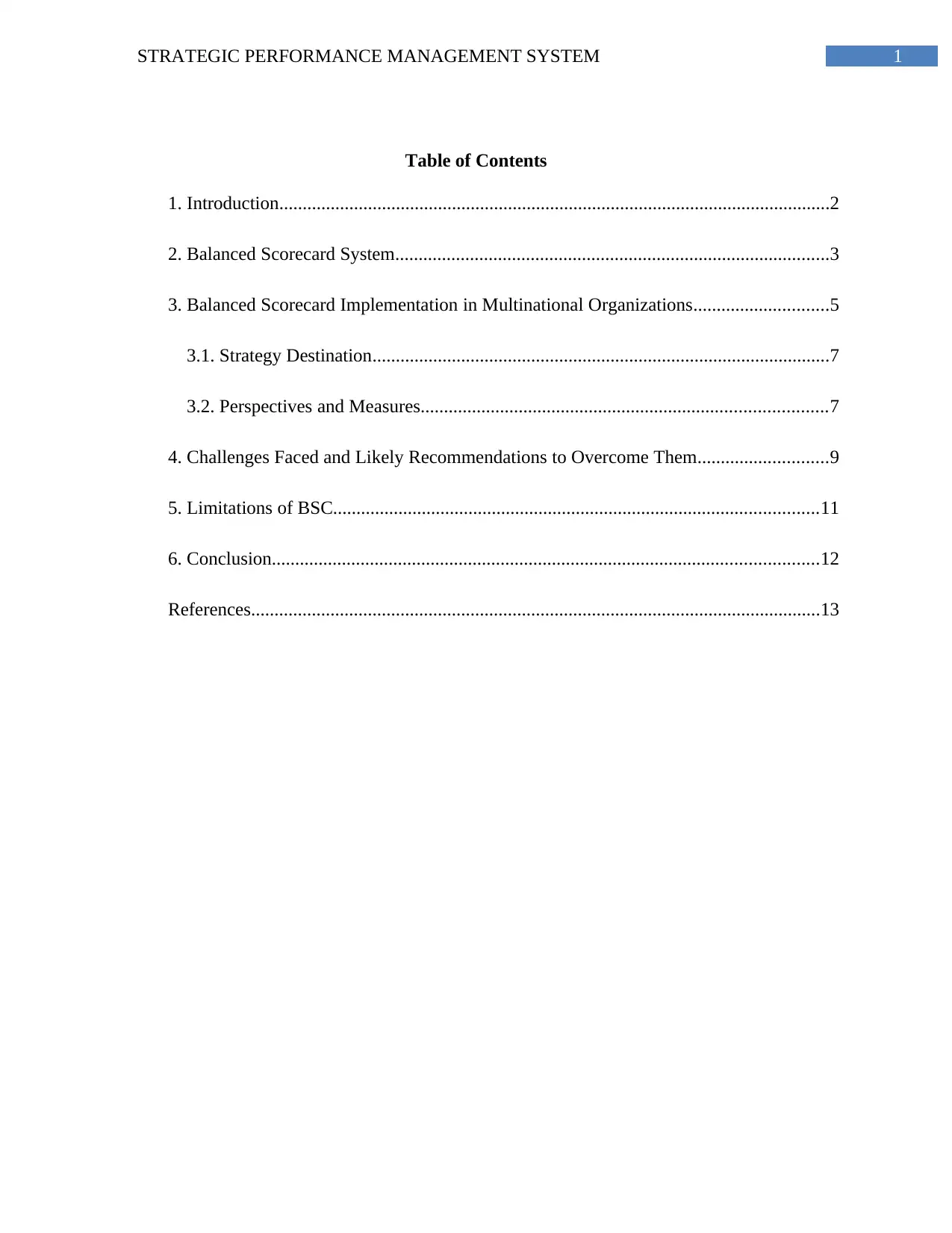
1STRATEGIC PERFORMANCE MANAGEMENT SYSTEM
Table of Contents
1. Introduction......................................................................................................................2
2. Balanced Scorecard System.............................................................................................3
3. Balanced Scorecard Implementation in Multinational Organizations.............................5
3.1. Strategy Destination..................................................................................................7
3.2. Perspectives and Measures.......................................................................................7
4. Challenges Faced and Likely Recommendations to Overcome Them............................9
5. Limitations of BSC........................................................................................................11
6. Conclusion.....................................................................................................................12
References..........................................................................................................................13
Table of Contents
1. Introduction......................................................................................................................2
2. Balanced Scorecard System.............................................................................................3
3. Balanced Scorecard Implementation in Multinational Organizations.............................5
3.1. Strategy Destination..................................................................................................7
3.2. Perspectives and Measures.......................................................................................7
4. Challenges Faced and Likely Recommendations to Overcome Them............................9
5. Limitations of BSC........................................................................................................11
6. Conclusion.....................................................................................................................12
References..........................................................................................................................13
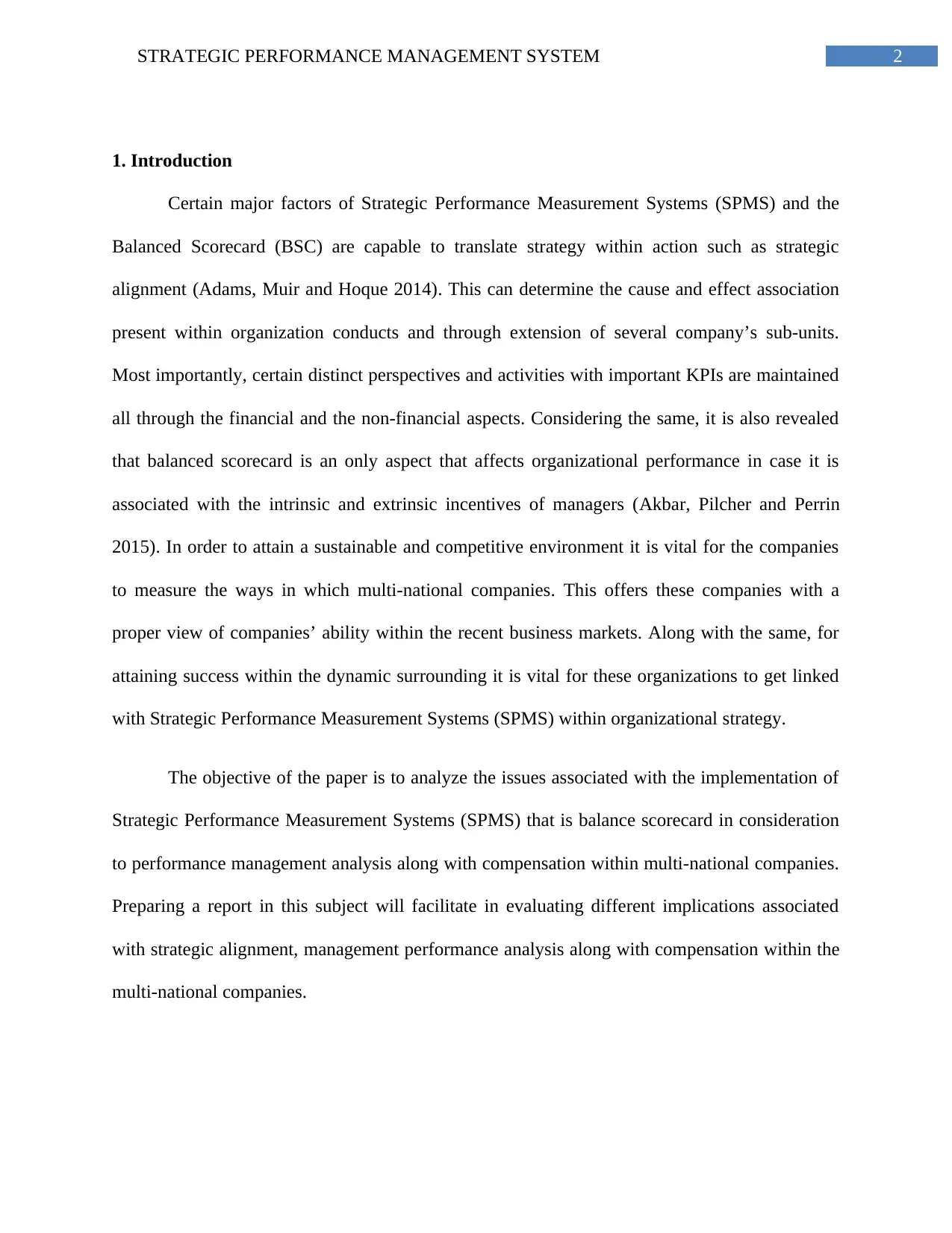
2STRATEGIC PERFORMANCE MANAGEMENT SYSTEM
1. Introduction
Certain major factors of Strategic Performance Measurement Systems (SPMS) and the
Balanced Scorecard (BSC) are capable to translate strategy within action such as strategic
alignment (Adams, Muir and Hoque 2014). This can determine the cause and effect association
present within organization conducts and through extension of several company’s sub-units.
Most importantly, certain distinct perspectives and activities with important KPIs are maintained
all through the financial and the non-financial aspects. Considering the same, it is also revealed
that balanced scorecard is an only aspect that affects organizational performance in case it is
associated with the intrinsic and extrinsic incentives of managers (Akbar, Pilcher and Perrin
2015). In order to attain a sustainable and competitive environment it is vital for the companies
to measure the ways in which multi-national companies. This offers these companies with a
proper view of companies’ ability within the recent business markets. Along with the same, for
attaining success within the dynamic surrounding it is vital for these organizations to get linked
with Strategic Performance Measurement Systems (SPMS) within organizational strategy.
The objective of the paper is to analyze the issues associated with the implementation of
Strategic Performance Measurement Systems (SPMS) that is balance scorecard in consideration
to performance management analysis along with compensation within multi-national companies.
Preparing a report in this subject will facilitate in evaluating different implications associated
with strategic alignment, management performance analysis along with compensation within the
multi-national companies.
1. Introduction
Certain major factors of Strategic Performance Measurement Systems (SPMS) and the
Balanced Scorecard (BSC) are capable to translate strategy within action such as strategic
alignment (Adams, Muir and Hoque 2014). This can determine the cause and effect association
present within organization conducts and through extension of several company’s sub-units.
Most importantly, certain distinct perspectives and activities with important KPIs are maintained
all through the financial and the non-financial aspects. Considering the same, it is also revealed
that balanced scorecard is an only aspect that affects organizational performance in case it is
associated with the intrinsic and extrinsic incentives of managers (Akbar, Pilcher and Perrin
2015). In order to attain a sustainable and competitive environment it is vital for the companies
to measure the ways in which multi-national companies. This offers these companies with a
proper view of companies’ ability within the recent business markets. Along with the same, for
attaining success within the dynamic surrounding it is vital for these organizations to get linked
with Strategic Performance Measurement Systems (SPMS) within organizational strategy.
The objective of the paper is to analyze the issues associated with the implementation of
Strategic Performance Measurement Systems (SPMS) that is balance scorecard in consideration
to performance management analysis along with compensation within multi-national companies.
Preparing a report in this subject will facilitate in evaluating different implications associated
with strategic alignment, management performance analysis along with compensation within the
multi-national companies.
⊘ This is a preview!⊘
Do you want full access?
Subscribe today to unlock all pages.

Trusted by 1+ million students worldwide
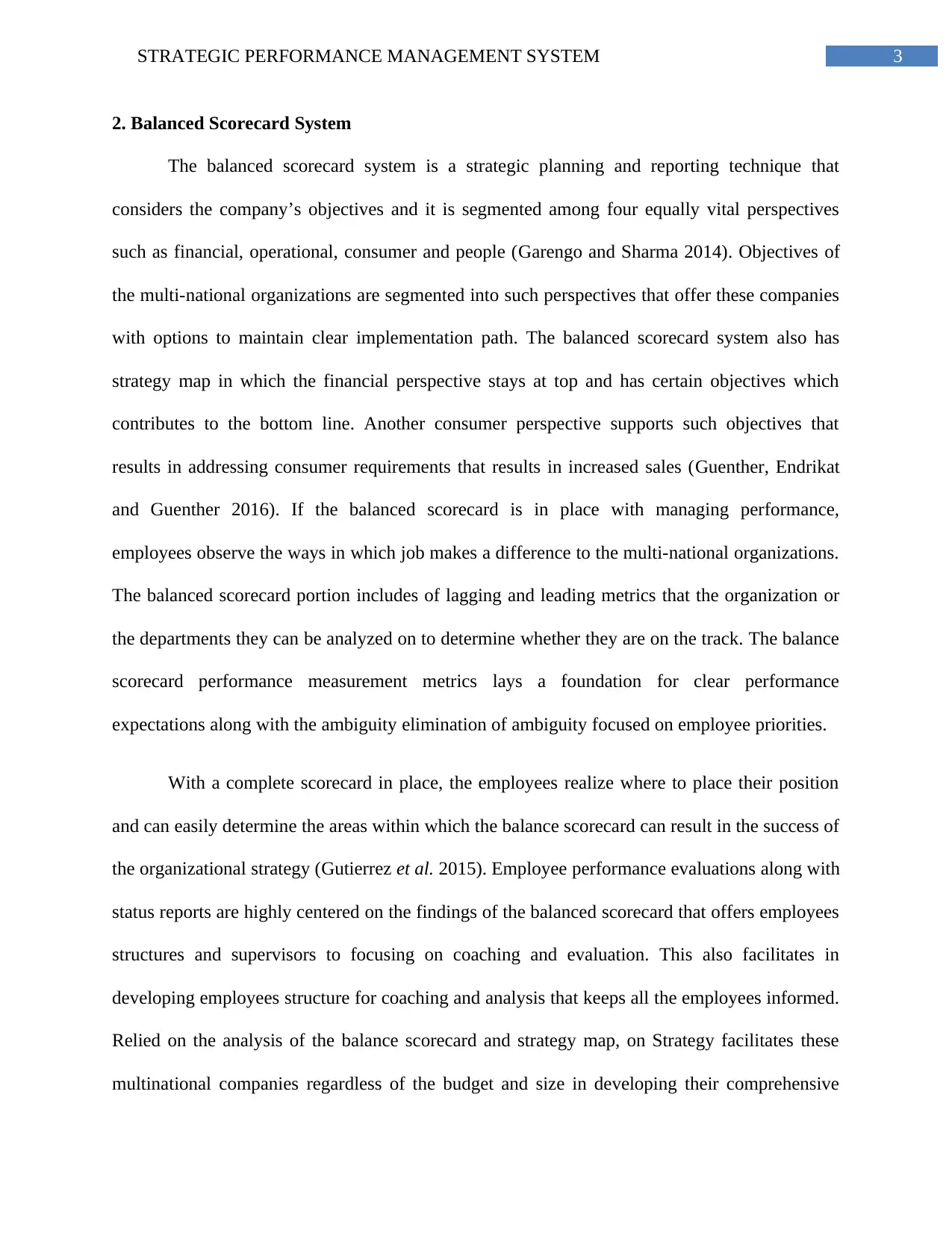
3STRATEGIC PERFORMANCE MANAGEMENT SYSTEM
2. Balanced Scorecard System
The balanced scorecard system is a strategic planning and reporting technique that
considers the company’s objectives and it is segmented among four equally vital perspectives
such as financial, operational, consumer and people (Garengo and Sharma 2014). Objectives of
the multi-national organizations are segmented into such perspectives that offer these companies
with options to maintain clear implementation path. The balanced scorecard system also has
strategy map in which the financial perspective stays at top and has certain objectives which
contributes to the bottom line. Another consumer perspective supports such objectives that
results in addressing consumer requirements that results in increased sales (Guenther, Endrikat
and Guenther 2016). If the balanced scorecard is in place with managing performance,
employees observe the ways in which job makes a difference to the multi-national organizations.
The balanced scorecard portion includes of lagging and leading metrics that the organization or
the departments they can be analyzed on to determine whether they are on the track. The balance
scorecard performance measurement metrics lays a foundation for clear performance
expectations along with the ambiguity elimination of ambiguity focused on employee priorities.
With a complete scorecard in place, the employees realize where to place their position
and can easily determine the areas within which the balance scorecard can result in the success of
the organizational strategy (Gutierrez et al. 2015). Employee performance evaluations along with
status reports are highly centered on the findings of the balanced scorecard that offers employees
structures and supervisors to focusing on coaching and evaluation. This also facilitates in
developing employees structure for coaching and analysis that keeps all the employees informed.
Relied on the analysis of the balance scorecard and strategy map, on Strategy facilitates these
multinational companies regardless of the budget and size in developing their comprehensive
2. Balanced Scorecard System
The balanced scorecard system is a strategic planning and reporting technique that
considers the company’s objectives and it is segmented among four equally vital perspectives
such as financial, operational, consumer and people (Garengo and Sharma 2014). Objectives of
the multi-national organizations are segmented into such perspectives that offer these companies
with options to maintain clear implementation path. The balanced scorecard system also has
strategy map in which the financial perspective stays at top and has certain objectives which
contributes to the bottom line. Another consumer perspective supports such objectives that
results in addressing consumer requirements that results in increased sales (Guenther, Endrikat
and Guenther 2016). If the balanced scorecard is in place with managing performance,
employees observe the ways in which job makes a difference to the multi-national organizations.
The balanced scorecard portion includes of lagging and leading metrics that the organization or
the departments they can be analyzed on to determine whether they are on the track. The balance
scorecard performance measurement metrics lays a foundation for clear performance
expectations along with the ambiguity elimination of ambiguity focused on employee priorities.
With a complete scorecard in place, the employees realize where to place their position
and can easily determine the areas within which the balance scorecard can result in the success of
the organizational strategy (Gutierrez et al. 2015). Employee performance evaluations along with
status reports are highly centered on the findings of the balanced scorecard that offers employees
structures and supervisors to focusing on coaching and evaluation. This also facilitates in
developing employees structure for coaching and analysis that keeps all the employees informed.
Relied on the analysis of the balance scorecard and strategy map, on Strategy facilitates these
multinational companies regardless of the budget and size in developing their comprehensive
Paraphrase This Document
Need a fresh take? Get an instant paraphrase of this document with our AI Paraphraser
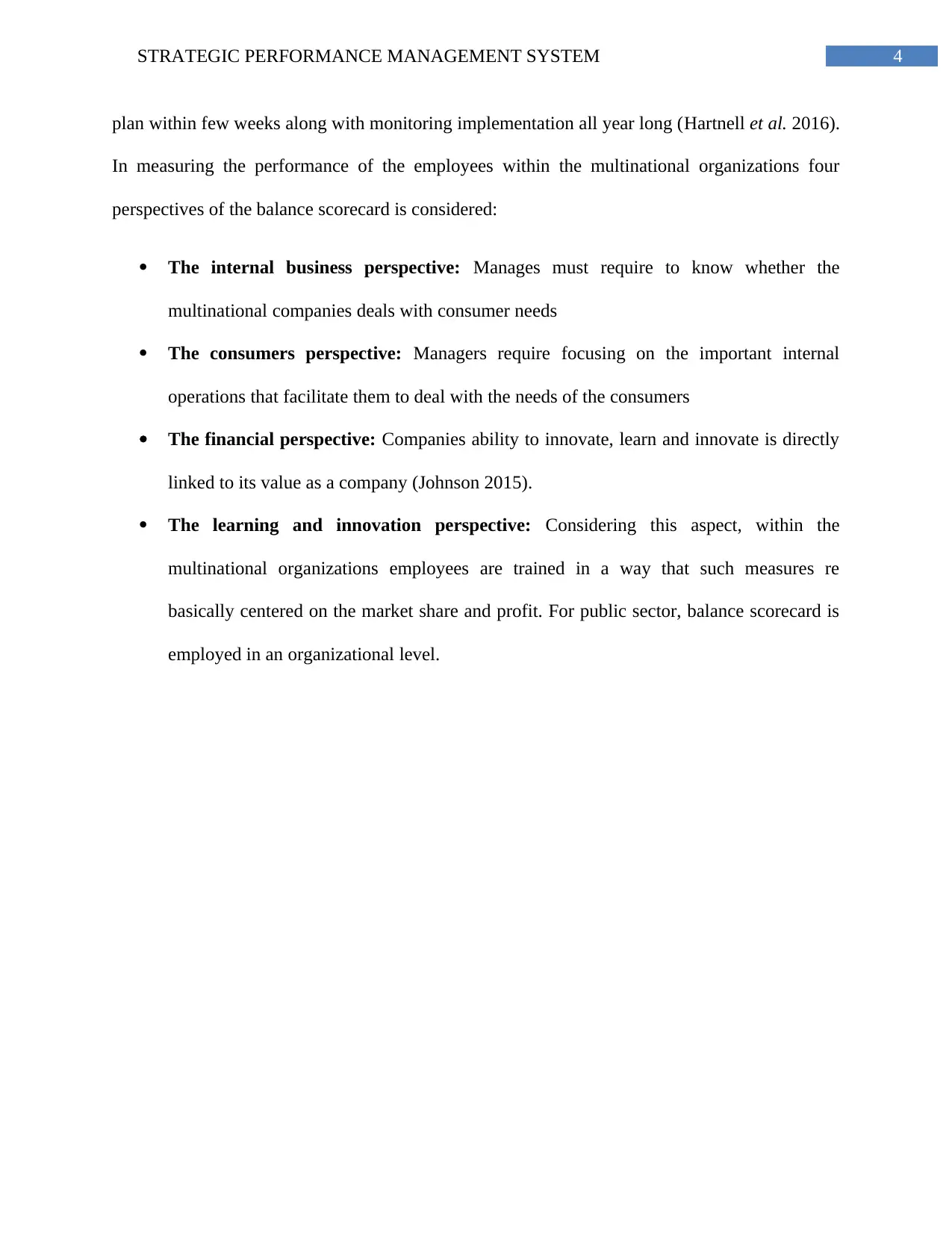
4STRATEGIC PERFORMANCE MANAGEMENT SYSTEM
plan within few weeks along with monitoring implementation all year long (Hartnell et al. 2016).
In measuring the performance of the employees within the multinational organizations four
perspectives of the balance scorecard is considered:
The internal business perspective: Manages must require to know whether the
multinational companies deals with consumer needs
The consumers perspective: Managers require focusing on the important internal
operations that facilitate them to deal with the needs of the consumers
The financial perspective: Companies ability to innovate, learn and innovate is directly
linked to its value as a company (Johnson 2015).
The learning and innovation perspective: Considering this aspect, within the
multinational organizations employees are trained in a way that such measures re
basically centered on the market share and profit. For public sector, balance scorecard is
employed in an organizational level.
plan within few weeks along with monitoring implementation all year long (Hartnell et al. 2016).
In measuring the performance of the employees within the multinational organizations four
perspectives of the balance scorecard is considered:
The internal business perspective: Manages must require to know whether the
multinational companies deals with consumer needs
The consumers perspective: Managers require focusing on the important internal
operations that facilitate them to deal with the needs of the consumers
The financial perspective: Companies ability to innovate, learn and innovate is directly
linked to its value as a company (Johnson 2015).
The learning and innovation perspective: Considering this aspect, within the
multinational organizations employees are trained in a way that such measures re
basically centered on the market share and profit. For public sector, balance scorecard is
employed in an organizational level.
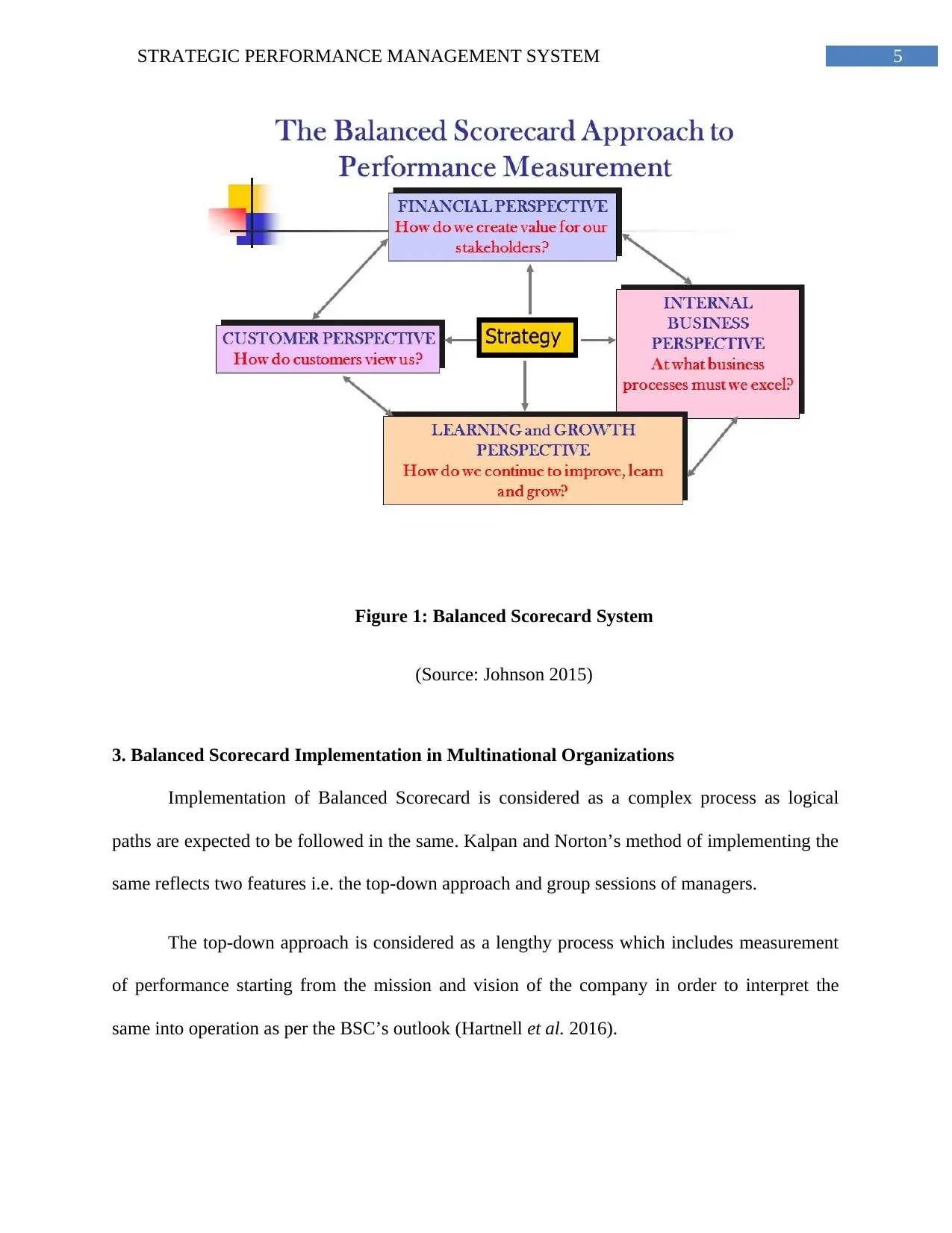
5STRATEGIC PERFORMANCE MANAGEMENT SYSTEM
Figure 1: Balanced Scorecard System
(Source: Johnson 2015)
3. Balanced Scorecard Implementation in Multinational Organizations
Implementation of Balanced Scorecard is considered as a complex process as logical
paths are expected to be followed in the same. Kalpan and Norton’s method of implementing the
same reflects two features i.e. the top-down approach and group sessions of managers.
The top-down approach is considered as a lengthy process which includes measurement
of performance starting from the mission and vision of the company in order to interpret the
same into operation as per the BSC’s outlook (Hartnell et al. 2016).
Figure 1: Balanced Scorecard System
(Source: Johnson 2015)
3. Balanced Scorecard Implementation in Multinational Organizations
Implementation of Balanced Scorecard is considered as a complex process as logical
paths are expected to be followed in the same. Kalpan and Norton’s method of implementing the
same reflects two features i.e. the top-down approach and group sessions of managers.
The top-down approach is considered as a lengthy process which includes measurement
of performance starting from the mission and vision of the company in order to interpret the
same into operation as per the BSC’s outlook (Hartnell et al. 2016).
⊘ This is a preview!⊘
Do you want full access?
Subscribe today to unlock all pages.

Trusted by 1+ million students worldwide
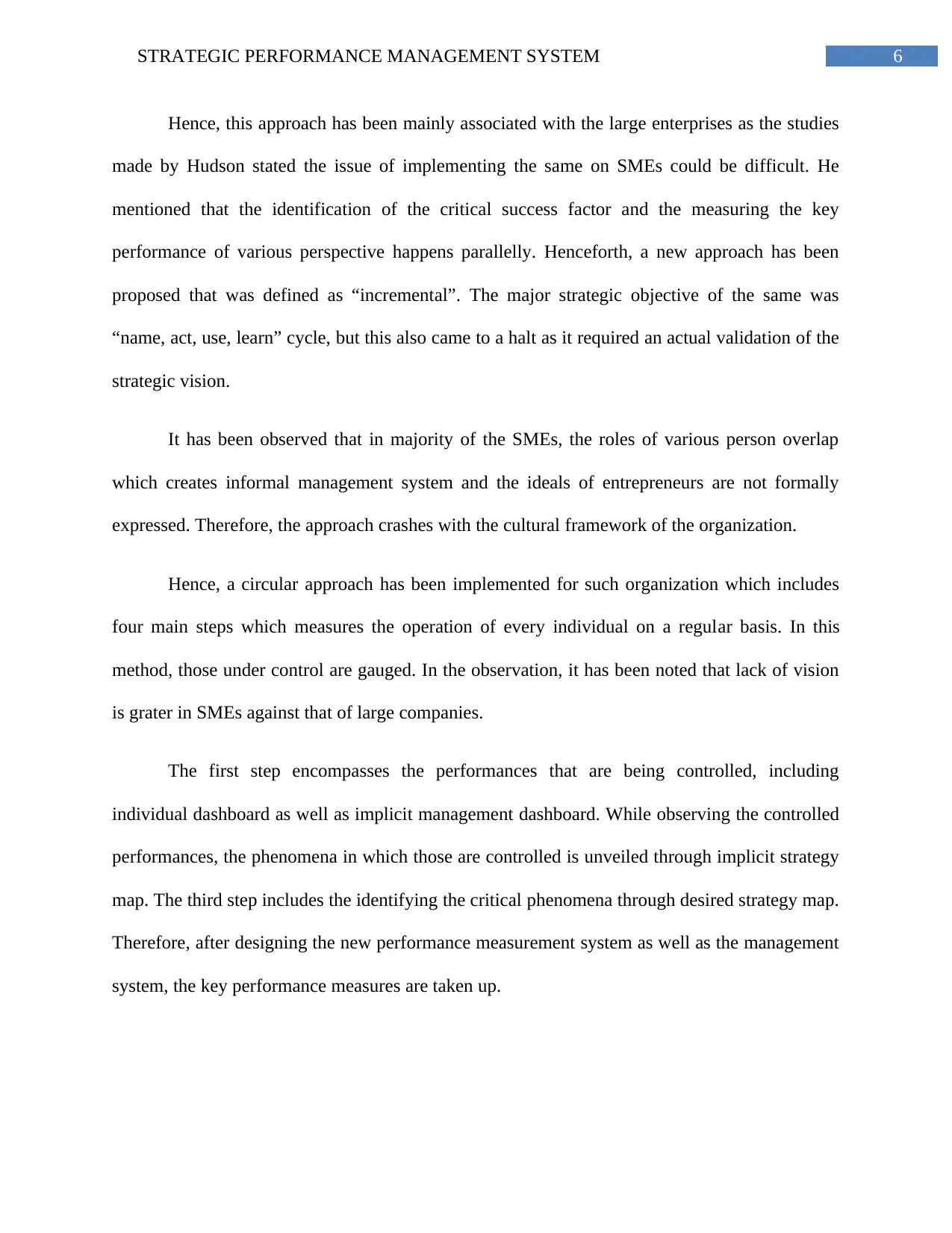
6STRATEGIC PERFORMANCE MANAGEMENT SYSTEM
Hence, this approach has been mainly associated with the large enterprises as the studies
made by Hudson stated the issue of implementing the same on SMEs could be difficult. He
mentioned that the identification of the critical success factor and the measuring the key
performance of various perspective happens parallelly. Henceforth, a new approach has been
proposed that was defined as “incremental”. The major strategic objective of the same was
“name, act, use, learn” cycle, but this also came to a halt as it required an actual validation of the
strategic vision.
It has been observed that in majority of the SMEs, the roles of various person overlap
which creates informal management system and the ideals of entrepreneurs are not formally
expressed. Therefore, the approach crashes with the cultural framework of the organization.
Hence, a circular approach has been implemented for such organization which includes
four main steps which measures the operation of every individual on a regular basis. In this
method, those under control are gauged. In the observation, it has been noted that lack of vision
is grater in SMEs against that of large companies.
The first step encompasses the performances that are being controlled, including
individual dashboard as well as implicit management dashboard. While observing the controlled
performances, the phenomena in which those are controlled is unveiled through implicit strategy
map. The third step includes the identifying the critical phenomena through desired strategy map.
Therefore, after designing the new performance measurement system as well as the management
system, the key performance measures are taken up.
Hence, this approach has been mainly associated with the large enterprises as the studies
made by Hudson stated the issue of implementing the same on SMEs could be difficult. He
mentioned that the identification of the critical success factor and the measuring the key
performance of various perspective happens parallelly. Henceforth, a new approach has been
proposed that was defined as “incremental”. The major strategic objective of the same was
“name, act, use, learn” cycle, but this also came to a halt as it required an actual validation of the
strategic vision.
It has been observed that in majority of the SMEs, the roles of various person overlap
which creates informal management system and the ideals of entrepreneurs are not formally
expressed. Therefore, the approach crashes with the cultural framework of the organization.
Hence, a circular approach has been implemented for such organization which includes
four main steps which measures the operation of every individual on a regular basis. In this
method, those under control are gauged. In the observation, it has been noted that lack of vision
is grater in SMEs against that of large companies.
The first step encompasses the performances that are being controlled, including
individual dashboard as well as implicit management dashboard. While observing the controlled
performances, the phenomena in which those are controlled is unveiled through implicit strategy
map. The third step includes the identifying the critical phenomena through desired strategy map.
Therefore, after designing the new performance measurement system as well as the management
system, the key performance measures are taken up.
Paraphrase This Document
Need a fresh take? Get an instant paraphrase of this document with our AI Paraphraser
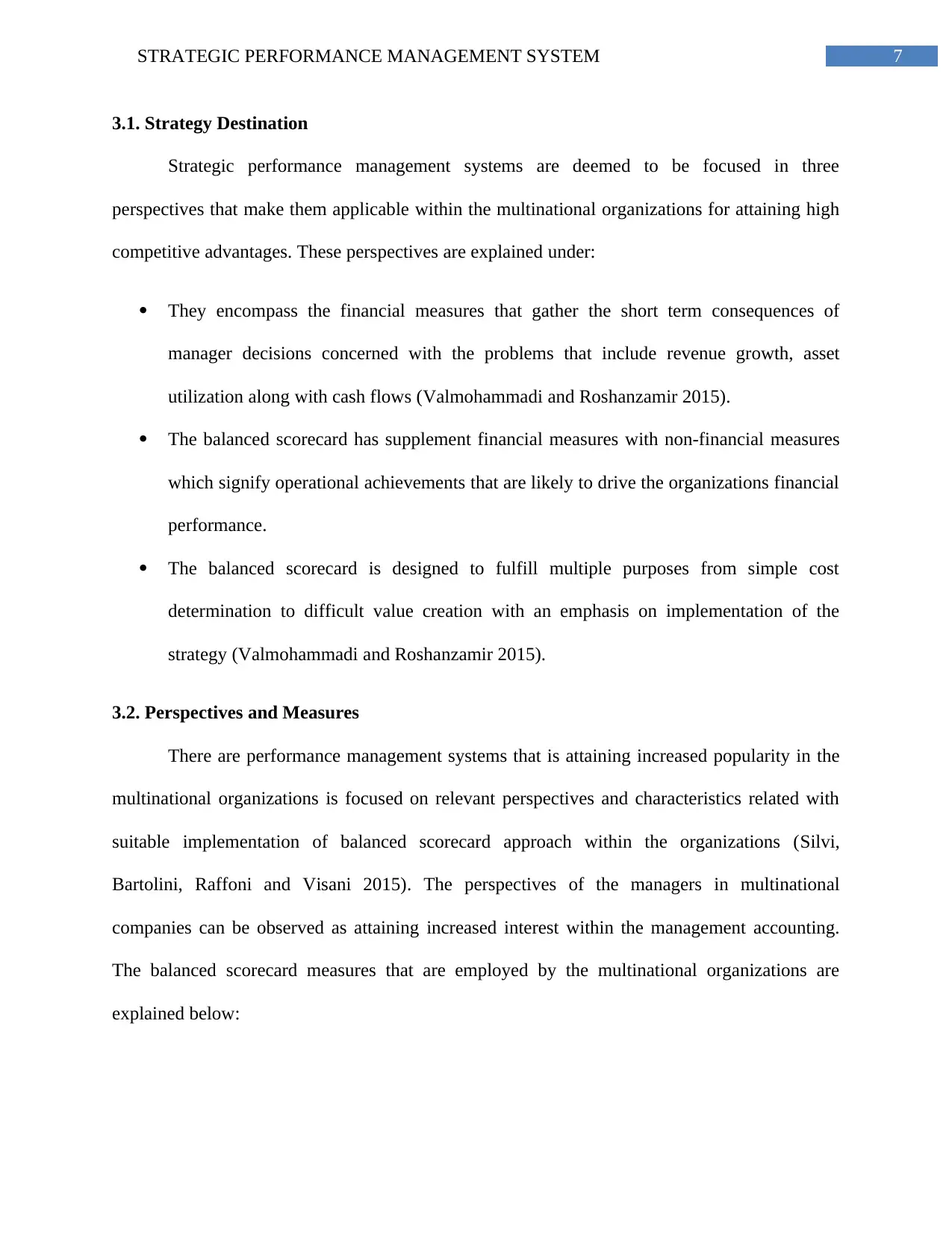
7STRATEGIC PERFORMANCE MANAGEMENT SYSTEM
3.1. Strategy Destination
Strategic performance management systems are deemed to be focused in three
perspectives that make them applicable within the multinational organizations for attaining high
competitive advantages. These perspectives are explained under:
They encompass the financial measures that gather the short term consequences of
manager decisions concerned with the problems that include revenue growth, asset
utilization along with cash flows (Valmohammadi and Roshanzamir 2015).
The balanced scorecard has supplement financial measures with non-financial measures
which signify operational achievements that are likely to drive the organizations financial
performance.
The balanced scorecard is designed to fulfill multiple purposes from simple cost
determination to difficult value creation with an emphasis on implementation of the
strategy (Valmohammadi and Roshanzamir 2015).
3.2. Perspectives and Measures
There are performance management systems that is attaining increased popularity in the
multinational organizations is focused on relevant perspectives and characteristics related with
suitable implementation of balanced scorecard approach within the organizations (Silvi,
Bartolini, Raffoni and Visani 2015). The perspectives of the managers in multinational
companies can be observed as attaining increased interest within the management accounting.
The balanced scorecard measures that are employed by the multinational organizations are
explained below:
3.1. Strategy Destination
Strategic performance management systems are deemed to be focused in three
perspectives that make them applicable within the multinational organizations for attaining high
competitive advantages. These perspectives are explained under:
They encompass the financial measures that gather the short term consequences of
manager decisions concerned with the problems that include revenue growth, asset
utilization along with cash flows (Valmohammadi and Roshanzamir 2015).
The balanced scorecard has supplement financial measures with non-financial measures
which signify operational achievements that are likely to drive the organizations financial
performance.
The balanced scorecard is designed to fulfill multiple purposes from simple cost
determination to difficult value creation with an emphasis on implementation of the
strategy (Valmohammadi and Roshanzamir 2015).
3.2. Perspectives and Measures
There are performance management systems that is attaining increased popularity in the
multinational organizations is focused on relevant perspectives and characteristics related with
suitable implementation of balanced scorecard approach within the organizations (Silvi,
Bartolini, Raffoni and Visani 2015). The perspectives of the managers in multinational
companies can be observed as attaining increased interest within the management accounting.
The balanced scorecard measures that are employed by the multinational organizations are
explained below:
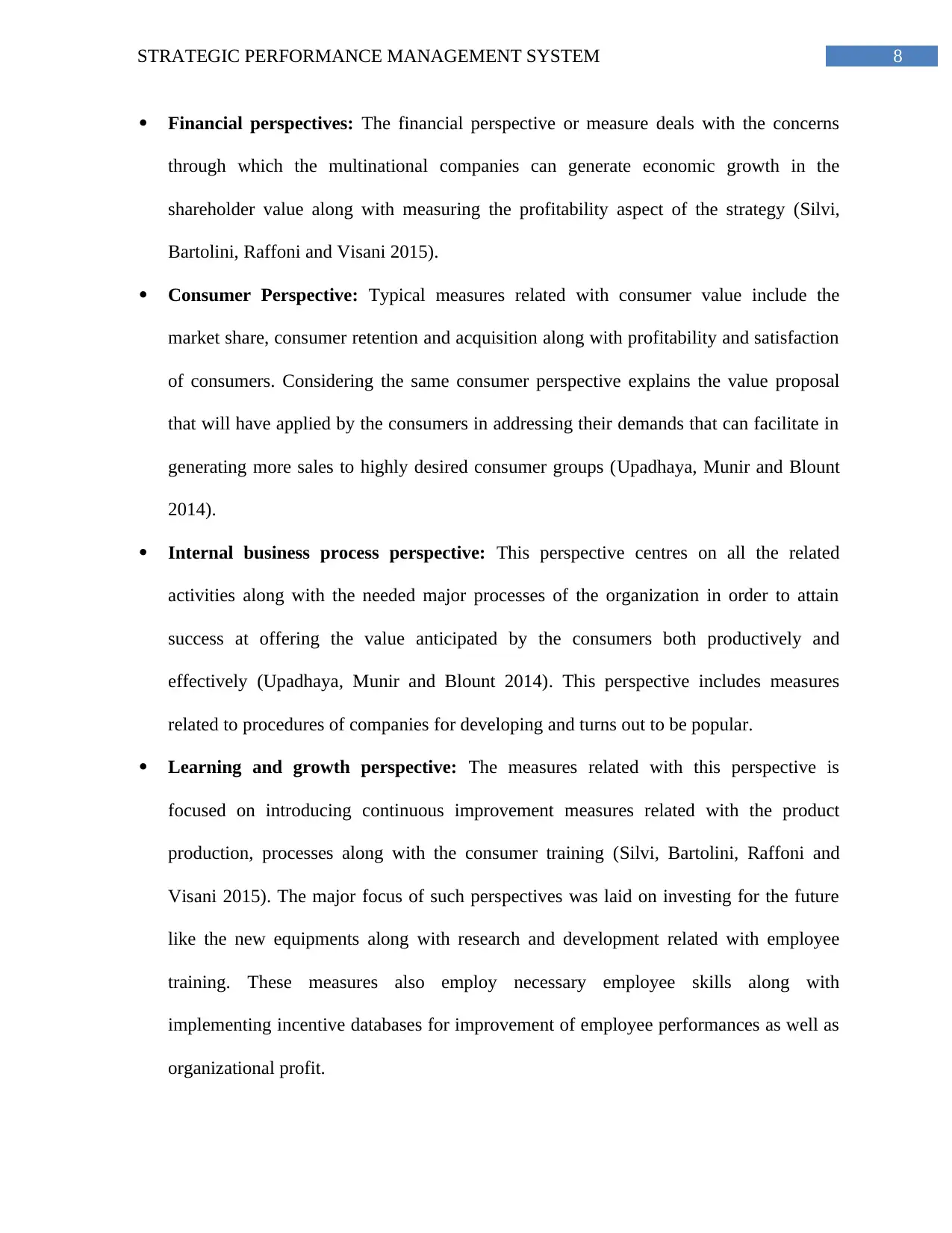
8STRATEGIC PERFORMANCE MANAGEMENT SYSTEM
Financial perspectives: The financial perspective or measure deals with the concerns
through which the multinational companies can generate economic growth in the
shareholder value along with measuring the profitability aspect of the strategy (Silvi,
Bartolini, Raffoni and Visani 2015).
Consumer Perspective: Typical measures related with consumer value include the
market share, consumer retention and acquisition along with profitability and satisfaction
of consumers. Considering the same consumer perspective explains the value proposal
that will have applied by the consumers in addressing their demands that can facilitate in
generating more sales to highly desired consumer groups (Upadhaya, Munir and Blount
2014).
Internal business process perspective: This perspective centres on all the related
activities along with the needed major processes of the organization in order to attain
success at offering the value anticipated by the consumers both productively and
effectively (Upadhaya, Munir and Blount 2014). This perspective includes measures
related to procedures of companies for developing and turns out to be popular.
Learning and growth perspective: The measures related with this perspective is
focused on introducing continuous improvement measures related with the product
production, processes along with the consumer training (Silvi, Bartolini, Raffoni and
Visani 2015). The major focus of such perspectives was laid on investing for the future
like the new equipments along with research and development related with employee
training. These measures also employ necessary employee skills along with
implementing incentive databases for improvement of employee performances as well as
organizational profit.
Financial perspectives: The financial perspective or measure deals with the concerns
through which the multinational companies can generate economic growth in the
shareholder value along with measuring the profitability aspect of the strategy (Silvi,
Bartolini, Raffoni and Visani 2015).
Consumer Perspective: Typical measures related with consumer value include the
market share, consumer retention and acquisition along with profitability and satisfaction
of consumers. Considering the same consumer perspective explains the value proposal
that will have applied by the consumers in addressing their demands that can facilitate in
generating more sales to highly desired consumer groups (Upadhaya, Munir and Blount
2014).
Internal business process perspective: This perspective centres on all the related
activities along with the needed major processes of the organization in order to attain
success at offering the value anticipated by the consumers both productively and
effectively (Upadhaya, Munir and Blount 2014). This perspective includes measures
related to procedures of companies for developing and turns out to be popular.
Learning and growth perspective: The measures related with this perspective is
focused on introducing continuous improvement measures related with the product
production, processes along with the consumer training (Silvi, Bartolini, Raffoni and
Visani 2015). The major focus of such perspectives was laid on investing for the future
like the new equipments along with research and development related with employee
training. These measures also employ necessary employee skills along with
implementing incentive databases for improvement of employee performances as well as
organizational profit.
⊘ This is a preview!⊘
Do you want full access?
Subscribe today to unlock all pages.

Trusted by 1+ million students worldwide
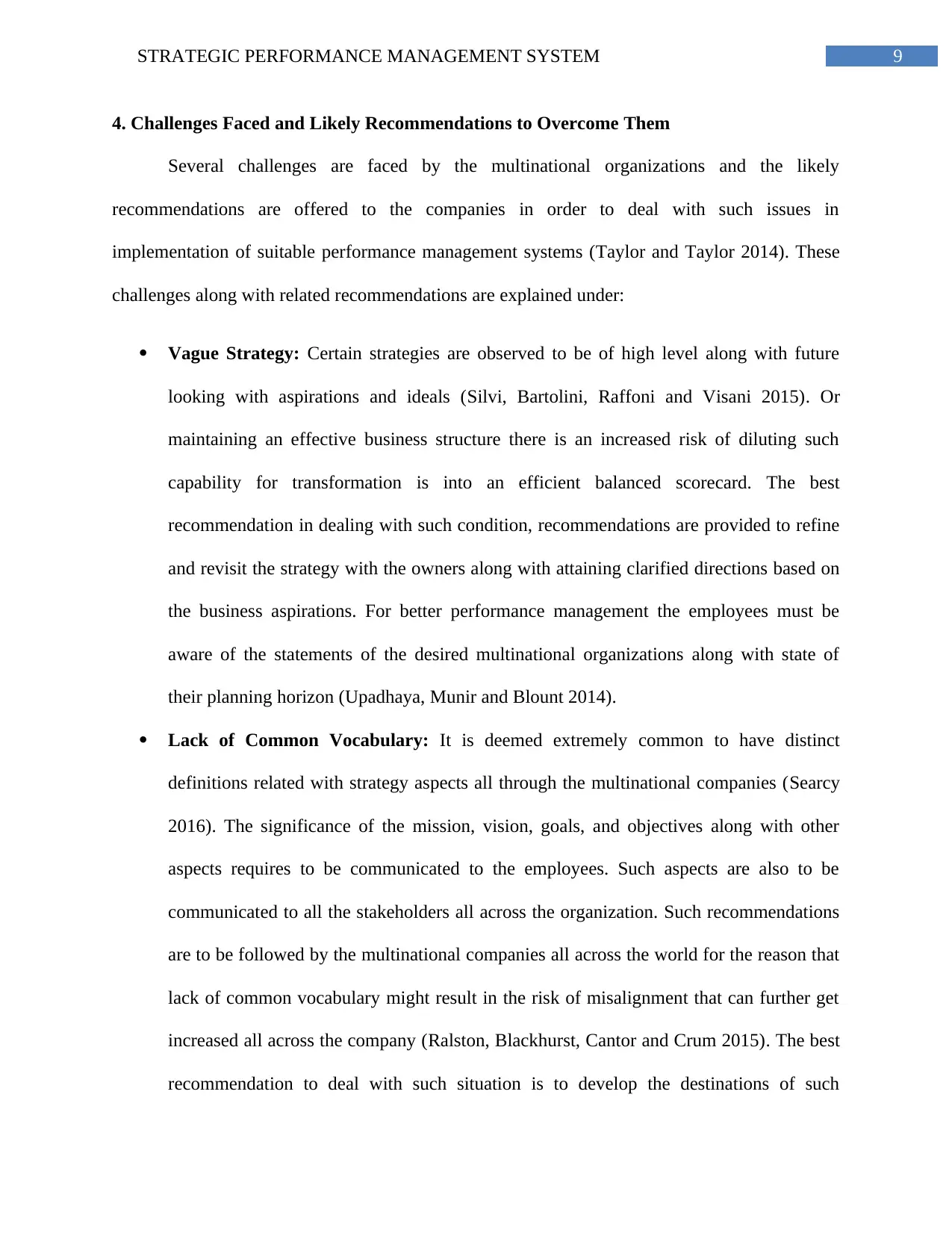
9STRATEGIC PERFORMANCE MANAGEMENT SYSTEM
4. Challenges Faced and Likely Recommendations to Overcome Them
Several challenges are faced by the multinational organizations and the likely
recommendations are offered to the companies in order to deal with such issues in
implementation of suitable performance management systems (Taylor and Taylor 2014). These
challenges along with related recommendations are explained under:
Vague Strategy: Certain strategies are observed to be of high level along with future
looking with aspirations and ideals (Silvi, Bartolini, Raffoni and Visani 2015). Or
maintaining an effective business structure there is an increased risk of diluting such
capability for transformation is into an efficient balanced scorecard. The best
recommendation in dealing with such condition, recommendations are provided to refine
and revisit the strategy with the owners along with attaining clarified directions based on
the business aspirations. For better performance management the employees must be
aware of the statements of the desired multinational organizations along with state of
their planning horizon (Upadhaya, Munir and Blount 2014).
Lack of Common Vocabulary: It is deemed extremely common to have distinct
definitions related with strategy aspects all through the multinational companies (Searcy
2016). The significance of the mission, vision, goals, and objectives along with other
aspects requires to be communicated to the employees. Such aspects are also to be
communicated to all the stakeholders all across the organization. Such recommendations
are to be followed by the multinational companies all across the world for the reason that
lack of common vocabulary might result in the risk of misalignment that can further get
increased all across the company (Ralston, Blackhurst, Cantor and Crum 2015). The best
recommendation to deal with such situation is to develop the destinations of such
4. Challenges Faced and Likely Recommendations to Overcome Them
Several challenges are faced by the multinational organizations and the likely
recommendations are offered to the companies in order to deal with such issues in
implementation of suitable performance management systems (Taylor and Taylor 2014). These
challenges along with related recommendations are explained under:
Vague Strategy: Certain strategies are observed to be of high level along with future
looking with aspirations and ideals (Silvi, Bartolini, Raffoni and Visani 2015). Or
maintaining an effective business structure there is an increased risk of diluting such
capability for transformation is into an efficient balanced scorecard. The best
recommendation in dealing with such condition, recommendations are provided to refine
and revisit the strategy with the owners along with attaining clarified directions based on
the business aspirations. For better performance management the employees must be
aware of the statements of the desired multinational organizations along with state of
their planning horizon (Upadhaya, Munir and Blount 2014).
Lack of Common Vocabulary: It is deemed extremely common to have distinct
definitions related with strategy aspects all through the multinational companies (Searcy
2016). The significance of the mission, vision, goals, and objectives along with other
aspects requires to be communicated to the employees. Such aspects are also to be
communicated to all the stakeholders all across the organization. Such recommendations
are to be followed by the multinational companies all across the world for the reason that
lack of common vocabulary might result in the risk of misalignment that can further get
increased all across the company (Ralston, Blackhurst, Cantor and Crum 2015). The best
recommendation to deal with such situation is to develop the destinations of such
Paraphrase This Document
Need a fresh take? Get an instant paraphrase of this document with our AI Paraphraser
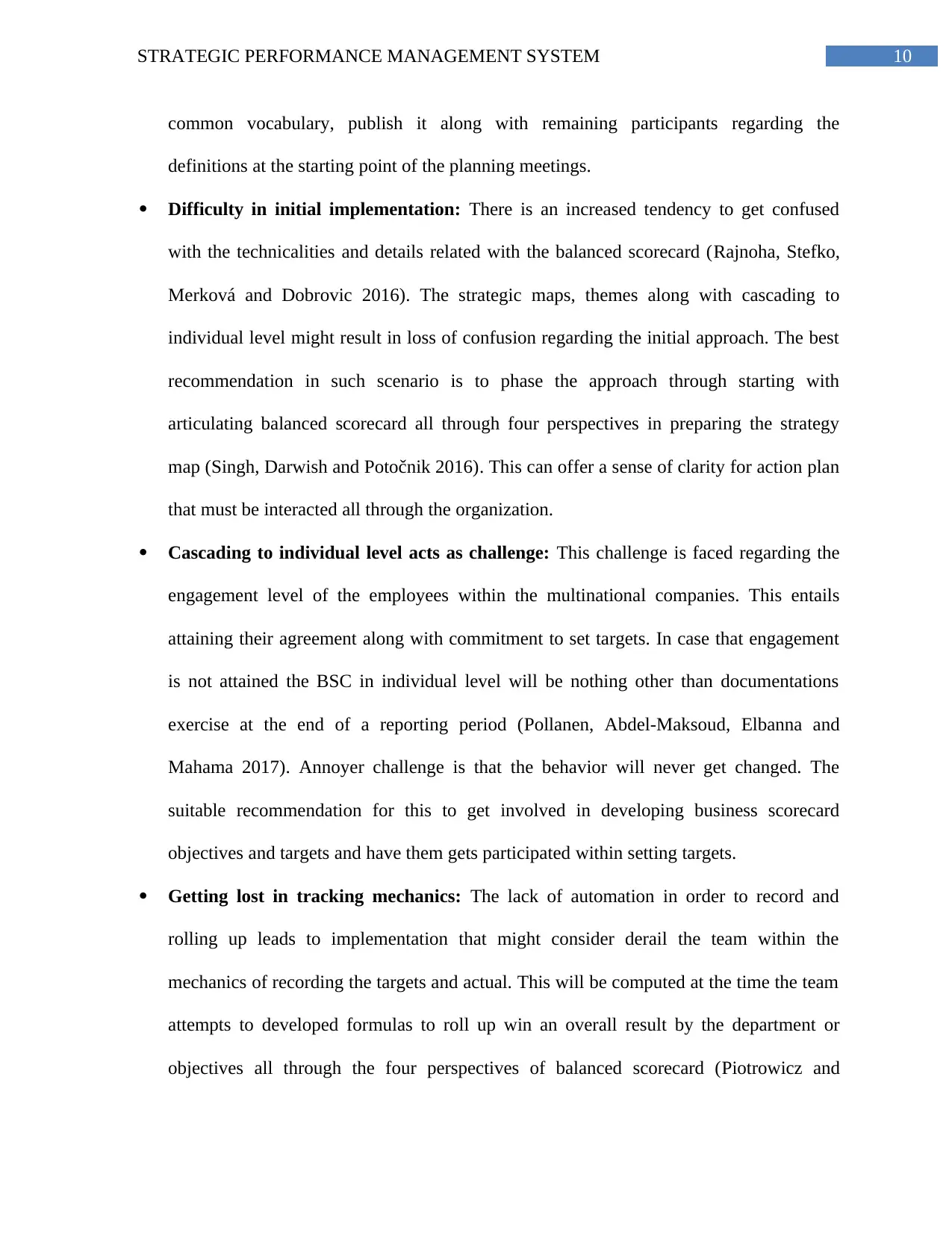
10STRATEGIC PERFORMANCE MANAGEMENT SYSTEM
common vocabulary, publish it along with remaining participants regarding the
definitions at the starting point of the planning meetings.
Difficulty in initial implementation: There is an increased tendency to get confused
with the technicalities and details related with the balanced scorecard (Rajnoha, Stefko,
Merková and Dobrovic 2016). The strategic maps, themes along with cascading to
individual level might result in loss of confusion regarding the initial approach. The best
recommendation in such scenario is to phase the approach through starting with
articulating balanced scorecard all through four perspectives in preparing the strategy
map (Singh, Darwish and Potočnik 2016). This can offer a sense of clarity for action plan
that must be interacted all through the organization.
Cascading to individual level acts as challenge: This challenge is faced regarding the
engagement level of the employees within the multinational companies. This entails
attaining their agreement along with commitment to set targets. In case that engagement
is not attained the BSC in individual level will be nothing other than documentations
exercise at the end of a reporting period (Pollanen, Abdel-Maksoud, Elbanna and
Mahama 2017). Annoyer challenge is that the behavior will never get changed. The
suitable recommendation for this to get involved in developing business scorecard
objectives and targets and have them gets participated within setting targets.
Getting lost in tracking mechanics: The lack of automation in order to record and
rolling up leads to implementation that might consider derail the team within the
mechanics of recording the targets and actual. This will be computed at the time the team
attempts to developed formulas to roll up win an overall result by the department or
objectives all through the four perspectives of balanced scorecard (Piotrowicz and
common vocabulary, publish it along with remaining participants regarding the
definitions at the starting point of the planning meetings.
Difficulty in initial implementation: There is an increased tendency to get confused
with the technicalities and details related with the balanced scorecard (Rajnoha, Stefko,
Merková and Dobrovic 2016). The strategic maps, themes along with cascading to
individual level might result in loss of confusion regarding the initial approach. The best
recommendation in such scenario is to phase the approach through starting with
articulating balanced scorecard all through four perspectives in preparing the strategy
map (Singh, Darwish and Potočnik 2016). This can offer a sense of clarity for action plan
that must be interacted all through the organization.
Cascading to individual level acts as challenge: This challenge is faced regarding the
engagement level of the employees within the multinational companies. This entails
attaining their agreement along with commitment to set targets. In case that engagement
is not attained the BSC in individual level will be nothing other than documentations
exercise at the end of a reporting period (Pollanen, Abdel-Maksoud, Elbanna and
Mahama 2017). Annoyer challenge is that the behavior will never get changed. The
suitable recommendation for this to get involved in developing business scorecard
objectives and targets and have them gets participated within setting targets.
Getting lost in tracking mechanics: The lack of automation in order to record and
rolling up leads to implementation that might consider derail the team within the
mechanics of recording the targets and actual. This will be computed at the time the team
attempts to developed formulas to roll up win an overall result by the department or
objectives all through the four perspectives of balanced scorecard (Piotrowicz and
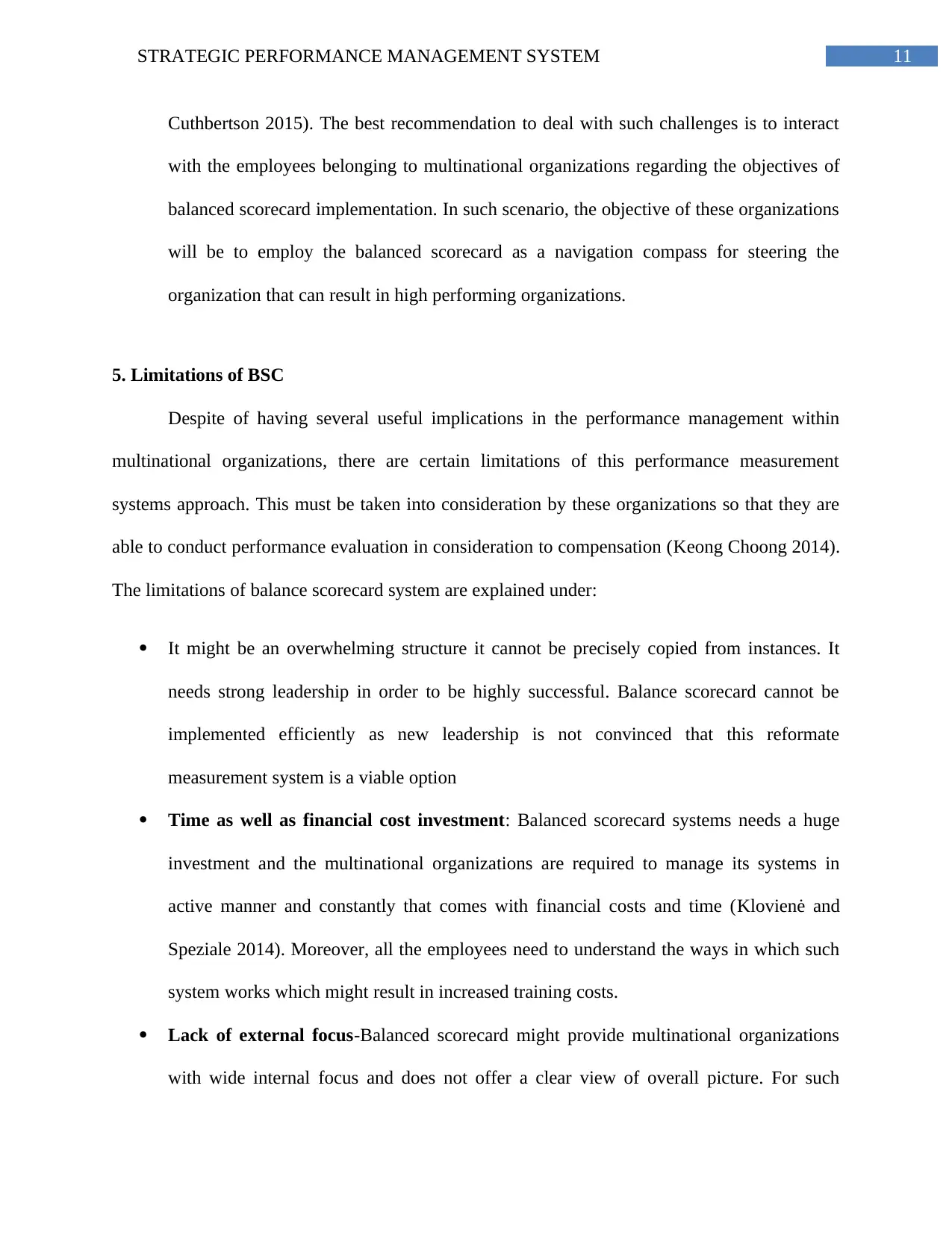
11STRATEGIC PERFORMANCE MANAGEMENT SYSTEM
Cuthbertson 2015). The best recommendation to deal with such challenges is to interact
with the employees belonging to multinational organizations regarding the objectives of
balanced scorecard implementation. In such scenario, the objective of these organizations
will be to employ the balanced scorecard as a navigation compass for steering the
organization that can result in high performing organizations.
5. Limitations of BSC
Despite of having several useful implications in the performance management within
multinational organizations, there are certain limitations of this performance measurement
systems approach. This must be taken into consideration by these organizations so that they are
able to conduct performance evaluation in consideration to compensation (Keong Choong 2014).
The limitations of balance scorecard system are explained under:
It might be an overwhelming structure it cannot be precisely copied from instances. It
needs strong leadership in order to be highly successful. Balance scorecard cannot be
implemented efficiently as new leadership is not convinced that this reformate
measurement system is a viable option
Time as well as financial cost investment: Balanced scorecard systems needs a huge
investment and the multinational organizations are required to manage its systems in
active manner and constantly that comes with financial costs and time (Klovienė and
Speziale 2014). Moreover, all the employees need to understand the ways in which such
system works which might result in increased training costs.
Lack of external focus-Balanced scorecard might provide multinational organizations
with wide internal focus and does not offer a clear view of overall picture. For such
Cuthbertson 2015). The best recommendation to deal with such challenges is to interact
with the employees belonging to multinational organizations regarding the objectives of
balanced scorecard implementation. In such scenario, the objective of these organizations
will be to employ the balanced scorecard as a navigation compass for steering the
organization that can result in high performing organizations.
5. Limitations of BSC
Despite of having several useful implications in the performance management within
multinational organizations, there are certain limitations of this performance measurement
systems approach. This must be taken into consideration by these organizations so that they are
able to conduct performance evaluation in consideration to compensation (Keong Choong 2014).
The limitations of balance scorecard system are explained under:
It might be an overwhelming structure it cannot be precisely copied from instances. It
needs strong leadership in order to be highly successful. Balance scorecard cannot be
implemented efficiently as new leadership is not convinced that this reformate
measurement system is a viable option
Time as well as financial cost investment: Balanced scorecard systems needs a huge
investment and the multinational organizations are required to manage its systems in
active manner and constantly that comes with financial costs and time (Klovienė and
Speziale 2014). Moreover, all the employees need to understand the ways in which such
system works which might result in increased training costs.
Lack of external focus-Balanced scorecard might provide multinational organizations
with wide internal focus and does not offer a clear view of overall picture. For such
⊘ This is a preview!⊘
Do you want full access?
Subscribe today to unlock all pages.

Trusted by 1+ million students worldwide
1 out of 16
Related Documents
Your All-in-One AI-Powered Toolkit for Academic Success.
+13062052269
info@desklib.com
Available 24*7 on WhatsApp / Email
![[object Object]](/_next/static/media/star-bottom.7253800d.svg)
Unlock your academic potential
Copyright © 2020–2025 A2Z Services. All Rights Reserved. Developed and managed by ZUCOL.





